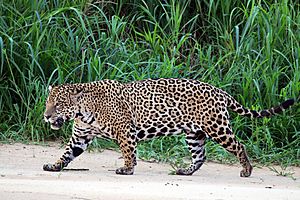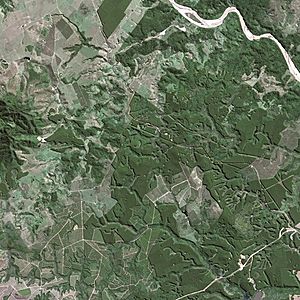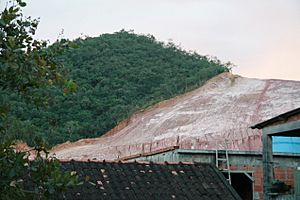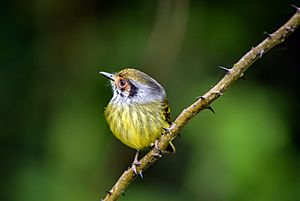Atlantic Forest facts for kids
Quick facts for kids Atlantic ForestMata Atlântica |
|
|---|---|
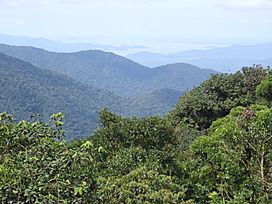
Area of the Atlantic Forest in Serra do Mar
|
|
| Map | |
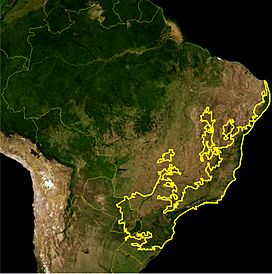
Map of the Atlantic Forest ecoregions as delineated by the WWF. The yellow line approximately encloses the forest's distribution.
(Satellite image from NASA) |
|
| Geography | |
| Location | Argentina, Brazil, Paraguay |
| Area | 1,315,460 km2 (507,900 sq mi) |
| UNESCO World Heritage Site | |
|---|---|

|
|
| Location | Brazil |
| Includes | Una Biological Reserve, PAU Brazil CEPLAC Experimental Station, Veracruz Station, Pau Brasil National Park, Descobrimento National Park, Monte Pascoal National Park, Linhares Forest Reserve and Sooretama Biological Reserve |
| Criteria | Natural: ix, x |
| Inscription | 1999 (23rd Session) |
| Area | 111,930 ha |
| UNESCO World Heritage Site | |
|---|---|
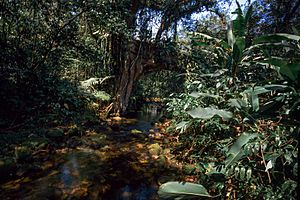
View from a trail in the Salto Morato Reserve
|
|
| Official name | Atlantic Forest South-East Reserves |
| Location | Paraná and São Paulo, Brazil |
| Includes | 25 protected areas |
| Criteria | Natural: (vii)(ix)(x) |
| Inscription | 1999 (23rd Session) |
| Area | 468,193 ha (1,807.70 sq mi) |
The Atlantic Forest (called Mata Atlântica in Portuguese) is a huge forest in South America. It stretches along the Atlantic coast of Brazil. It also reaches into Paraguay and Argentina. In Argentina, it's known as Selva Misionera.
This forest is home to many different types of environments. These include wet and dry tropical forests, grasslands, and mangrove forests. The Atlantic Forest is famous for its amazing biodiversity, meaning it has a huge variety of life. Many species found here live nowhere else in the world.
When Portuguese explorers first arrived over 500 years ago, this forest was enormous. It was thought to cover between 1 million and 1.5 million square kilometers. This made it the second largest rainforest on Earth, after the Amazon rainforest. Sadly, over 85% of the original forest has been cut down. This deforestation puts many plants and animals in danger of extinction.
Contents
What Makes the Atlantic Forest Special?
The Atlantic Forest is not just one type of forest. It includes several different kinds of forests and habitats:
- Restinga is a forest that grows on stable sand dunes near the coast. These forests can be dense with short trees. Sometimes, they are more open, like a savanna, with scattered trees and shrubs.
- Tropical Moist Forests get a lot of rain, sometimes more than 2,000 millimeters a year. These include forests found in lowlands, on hills, and in mountains.
- Tabuleiro Forests grow on very wet clay soils. Tabuleiro Savannas are found on sandier soils that drain faster. These areas are humid because of moisture from the ocean.
- Atlantic Dry Forests are found further inland. They are a link between the dry Caatinga region and the Cerrado grasslands. These forests are shorter and more open. They have many trees that lose their leaves in the dry season. They get 700–1,600 millimeters of rain each year, with a clear dry period.
- Montane Forests are wet forests found at higher altitudes in southern Brazil. They are also called Araucaria moist forests.
- Mussununga Forests are found in southern Bahia and northern Espirito Santo states. This ecosystem can range from grasslands to woodlands. The name Mussununga means "soft and wet white sand" in an old Amerindian language.
- Shrubby Montane Savannas grow at the highest elevations. These are also known as Campo rupestre.
The Atlantic Forest is special because it's a true tropical rain forest that reaches far south, to about 28°S latitude. This happens because trade winds bring rain even during the southern winter.
Where is the Atlantic Forest?
The Atlantic Forest is mostly in eastern Brazil. About 92% of its total area is there. It also stretches into eastern Paraguay, covering about 6% of the forest. A smaller part, about 2%, is in northeastern Argentina.
A Look Back in Time
During the Ice Ages, called the Pleistocene period, the Atlantic Forest became much smaller. It survived in tiny, protected areas like deep valleys. These areas were surrounded by dry forests or semi-deserts. Scientists believe the forest managed to survive in moist pockets away from the coast.
Amazing Plants and Animals
Even though much of the Atlantic Forest is gone, it is still incredibly rich in biodiversity. It has many endemic species, which means they are found nowhere else on Earth. Sadly, many of these unique species are in danger of extinction.
About 40% of its vascular plants (plants with tubes for water) and up to 60% of its vertebrates (animals with backbones) are endemic. Brazil's official list of threatened species includes over 140 types of mammals from the Atlantic Forest. In Paraguay, 35 species are threatened, and in Argentina, 22 species are threatened.
Nearly 250 species of amphibians, birds, and mammals have already disappeared. This has happened because of human activities over the last 400 years. Today, more than 11,000 species of plants and animals in the Atlantic Forest are considered threatened. Over half of the tree species and 92% of the amphibians are unique to this area. The forest is home to about 20,000 plant species. In some places, you can find almost 450 different tree species in just one hectare (about 2.5 acres)!
The Atlantic Forest is one of the most studied tropical ecosystems. For example, scientists have recorded over 3,000 tree species, 98 bat species, and 800 bird species here.
New species are still being found in the Atlantic Forest all the time. Between 1990 and 2006, over a thousand new flowering plants were discovered. In 1990, researchers even found a small group of black-faced lion tamarins. These small monkeys were thought to be extinct! A new type of blonde capuchin monkey was found in 2006. Also, the maned sloth, an endangered three-toed sloth, lives only in the Atlantic Forest.
Protecting the Forest
How Humans Have Changed the Forest
Modern human societies need forest resources. This has greatly reduced the size of the Atlantic Forest. Almost 88% of the original forest has been lost. It has been replaced by farms, pastures, and cities. This cutting down of trees continues at a rate of 0.5% each year. In city areas, it can be as high as 2.9%.
- Farming: A large part of the land in the Atlantic Forest is used for agriculture. Farmers grow crops like sugar-cane, coffee, tea, and tobacco. More recently, they also grow soybeans and crops for biofuel.
- Cattle Pastures: Even more common than farming is turning forest land into pastures for cattle. This is often done by slash and burn methods. This makes the forest more likely to catch fire from human activity.
- Hunting: Animals in a forest that has been broken into smaller pieces are easier to hunt. They are in a smaller area that hunters can reach. Larger animals are often hunted the most. This changes how species interact, like how seeds are spread or how they compete for food.
- Logging: Cutting down trees (logging) removes a lot of the forest's top layer (canopy). This makes the habitat more open to wind and sunlight. The forest gets hotter and drier. A lot of dead leaves and branches build up on the ground. This makes the forest more likely to catch fire. Also, logging roads make it easier for people to get into the forest. This leads to more human disturbances and less natural forest.
- Fire: Human activities like logging create a lot of dry material on the forest floor. This makes the Atlantic Forest more likely to burn. This type of forest is not used to regular fires. So, human-caused fires greatly harm the plants on the forest floor. These plants don't have ways to survive fires. This makes the forest even more open to future fires, which are much more damaging.
What Happens When Forests Are Fragmented?
When a forest is broken into smaller pieces (called Habitat fragmentation), it causes many changes. For example, the destruction of habitat in the Atlantic Forest has led to an extinction crisis. Species that live only in this region are very vulnerable. This is because they live in small areas and are not found often. In one study, the amount of living material in forest pieces smaller than 25 hectares was reduced by 60%.
Important natural processes like seed dispersal (how seeds are spread), gene flow (how genes move between groups), and colonization are disturbed. Many important animals that spread seeds are disappearing. This means many fruit-bearing trees in the Atlantic Forest might also disappear. This would happen because their seeds won't be planted in new places. With so many species already threatened, scientists predict that if deforestation continues, more species will become extinct.
Helping the Forest: Conservation Efforts
Because the Atlantic Forest has so many unique plants and animals, many groups are working to save this special ecosystem. Non-governmental organizations (NGOs) play a big role in Brazil. They provide money and expert help to the Atlantic Forest.
One organization, BirdLife International, uses its research to protect the area's bird diversity. They also teach people how to use natural resources in a way that doesn't harm the environment.
Some organizations get money from the Critical Ecosystem Partnership Fund. They follow rules to protect species, support private nature reserves, and strengthen their own groups.
Another way to protect the Atlantic Forest is by creating wildlife corridors. These are strips of habitat that connect smaller forest pieces. This allows animals to move safely between them. The World Bank is giving $44 million to create a corridor in the Atlantic Forest. It will be called the Central Biodiversity Corridor. The Brazilian Development Bank is also funding projects to restore 3,500 hectares of the forest.
To protect diversity, the state of Sao Paulo created the Restinga de Bertioga State Park. This park is 9.3 thousand hectares. It also acts as a wildlife corridor, connecting coastal areas to the Serra do Mar mountains. Groups like the Nature Conservancy plan to restore lost parts of the forest. They also want to build corridors that work with the lives of local people. The Amazon Institute is actively replanting trees in northeastern Brazil.
The Pact for Atlantic Forest Restoration is a group of over 100 businesses, NGOs, and government organizations. Their goal is to restore 15 million hectares of the original ecosystem by 2050.
The Pontifícia Universidade Católica do Rio Grande do Sul has a private reserve called Pró-Mata. It's about 3,100 hectares and is used for research and protecting biodiversity.
Different Forest Types (Ecoregions)
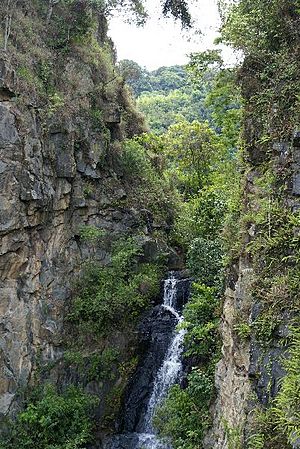
The Atlantic Forest is made up of several different Terrestrial ecoregions. These include:
- Tropical and subtropical moist broadleaf forests:
- Alto Paraná Atlantic forests
- Araucaria moist forests
- Atlantic Coast restingas
- Bahia coastal forests
- Bahia interior forests
- Caatinga enclaves moist forests
- Pernambuco coastal forests
- Pernambuco interior forests
- Serra do Mar coastal forests
- Tropical and subtropical dry broadleaf forests:
- Atlantic dry forests
- Tropical and subtropical grasslands, savannas, and shrublands:
- Campos rupestres
- Mangrove forests:
- Bahia mangroves
- Ilha Grande mangroves
- Rio Piranhas mangroves
- Rio São Francisco mangroves
See also
 In Spanish: Mata atlántica para niños
In Spanish: Mata atlántica para niños
- Atlantic Forest Biosphere Reserve
- Biodiversity hotspot
- Instituto de Tecnologia Intuitiva e Bio-Arquitetura
- List of ecoregions in Brazil
- List of plants of Atlantic Forest vegetation of Brazil


